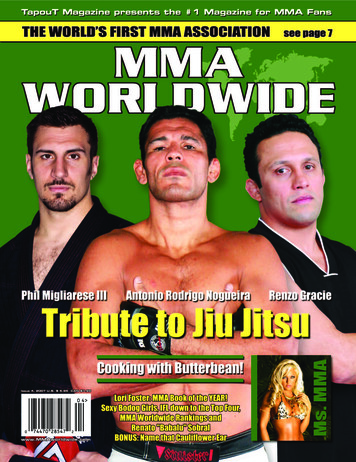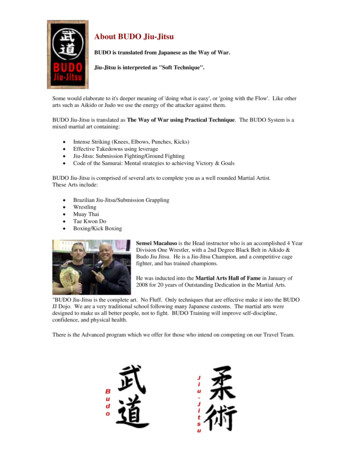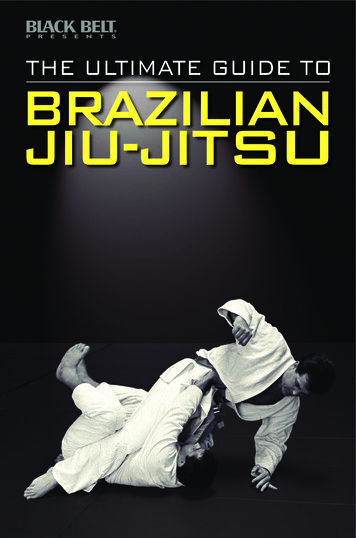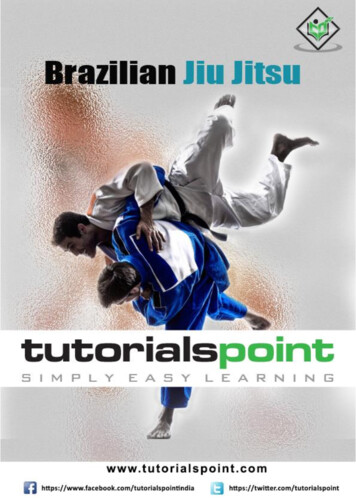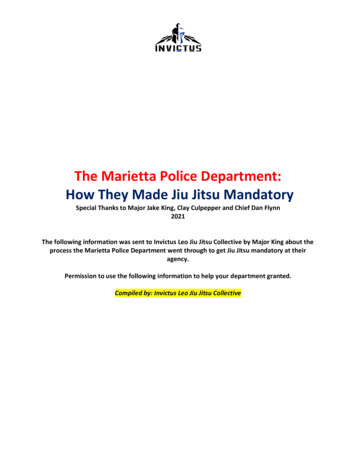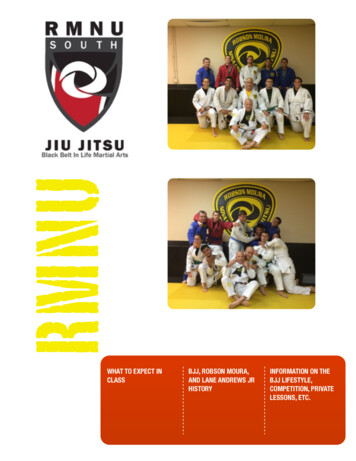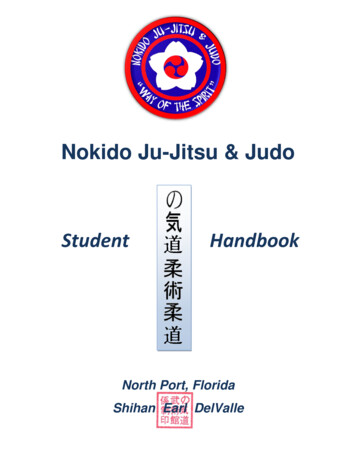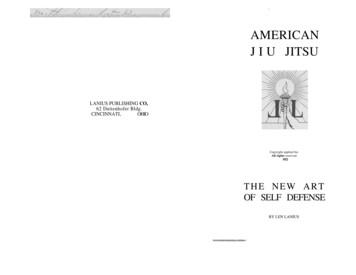
Transcription
Gracie Jiu-JitsubyGrand MasterHelio GracieREVISED EDITIONGracie PublicationsTorrance, California
DISCLAIMERPlease note that the author and publisher of this book are NOT RESPONSIBLE in anymanner whatsoever for any injury that may result from practicing the techniques and/or following the instructions given within. Since the physical activities described hereinmay be too strenuous in nature for some readers to engage in safely, it is essential that aphysician be consulted prior to training.First published in 2005 Gracie PublicationsCopyright 2005 & 2020 by Gracie PublicationsAll rights reserved. No part of this publication may be reproduced or utilized in any formor by any means, electronic or mechanical, including photocopying, recording, or byany information storage and retrieval system, without prior written permission fromGracie Publications.Library of Congress PCN Number: 2004095757ISBN: 978-0-9759411-3-3Printed in Asia.Gracie Publicationswww.graciemuseum.comwww.graciediet.com
To teach those who don’t know,To remind those who do know,To correct those who think they know.– Helio Gracie
AcknowledgementsFor many years I felt that Gracie Jiu-Jitsu, arguably the most revolutionary style in martial arts history,needed to be presented in its original form, in an organized fashion, for the benefit of future generations.I knew that no one could do a better job of demonstrating and teaching the techniques than Helio Graciehimself, the creator of Gracie Jiu-Jitsu.In the summer of 2000, with my father scheduled to arrive in Los Angeles in a matter of weeks, I startedasking around, looking for a photographer. One day, I received an unexpected phone call.“Hey, Rorion,” the voice on the other end said, “look no further. I’m going to shoot your father’s book.”“What makes you think that?” I asked, a little taken aback.“Because I can’t take a bad picture,” the voice confidently replied.He sounded like me when I say I can’t teach a bad class! I concluded this guy was either really crazy orreally good, so we scheduled a meeting. The next day, an unassuming Thomas de Soto walked into my office.Tommy’s portfolio was extremely impressive. His lenses have captured everything from komodo dragons inIndonesia and alligators in Africa, to a Who’s Who list of celebrities and sports legends, covering everyonefrom Mick Jagger to Tiger Woods. Tommy’s photographic talents were the perfect complement for the bookI’d been dreaming of.After the usual small talk, I fired off the sixty-four-dollar question, “How much do you charge?”With a small smile, he replied, “My going rate is an hour.”“It was nice meeting you,” I replied, standing up and reaching out to shake his hand, “but I can’t afford that.”Tommy smiled again and said, “But I’m not going to charge you anything.”For several moments I was speechless – which is unusual for me. Then I sat back down and managedto say, “Why is that?”Tommy looked straight into my eyes with the utmost sincerity, “I want to be able to tell my grandchildren that I photographed Helio Gracie’s book.”We made plans to improvise a photo studio at the Gracie Jiu-Jitsu Academy in Torrance, California, soshooting could begin immediately upon my father’s arrival. What I originally estimated would take a fewdays and consist of 700 photos took two weeks and resulted in 3500 images! Tommy’s 1000 best shots wereselected and are presented in this book.Besides Tommy, whom I can never thank enough, many friends put their helping hands to work and thewhole project seemed to materialize out of thin air. Spiro Demetriadi provided the material for the photoset; Glenn Flojo made a special arrangement at a local hotel so Tommy did not have to drive back to SanDiego every night. Julian M. Climaco supervised the film processing and had the slides ready at lightningspeed so that Basilio R. Seixas could put them in order for my daily review. Also, Jose M. Fraguas gave megreat advice on book structure and design; Eric Sherman was added to the team for his editing talent; andPedro and Guilherme Valente provided valuable input.I also want to acknowledge the contribution of the entire Gracie family for their continuous effort topreserve and honor the Gracie legacy.A special thanks goes out to all my children for giving me the wonderful joys and lessons of fatherhood,and to my wife, Silvia, for showing me the true meaning of love.Most importantly, I want to express the deep gratitude and respect I have for my father, Helio Gracie, whohas been a source of inspiration to me throughout my life, both on and off the mat.Rorion Gracie
ContentsThe History of Gracie Jiu-Jitsu. . . . . . . . . . . . . . . . . . . . . . . . . . . . . . . . . . . . . . . 1Introduction . . . . . . . . . . . . . . . . . . . . . . . . . . . . . . . . . . . . . . . . . . . . . . . . . . . . . . 11CHAPTER 1 – STANDING DEFENSES FROM THE FRONT20 – Hip throw58 – Headlock defense (pressure on the nose)22 – Two-hand front choke defense60 – Headlock defense against a wall24 – Two-hand front choke defense(attacker outside)(with hip throw)62 – Headlock defense against a wall26 – Two-hand front choke defense(attacker inside)(with armlock)64 – Guillotine defense (sitting back)28 – Two-hand front choke defense66 – Guillotine defense (sliding down)(against a wall)68 – Guillotine defense (with trip takedown)30 – Single-hand front choke defense70 – Guillotine choke(against a wall)72 – Guillotine choke (if taken down)31 – Wall-pin defense74 – Tackle defense (with elbow strike)32 – Single-hand collar grab defense75 – Tackle defense (with knee strike)33 – Single-hand collar grab defense (wrist fold)76 – Front bear hug over the arms defense34 – Single-hand collar grab defense78 – Front bear hug under arms defense(palm turned up)(with frame)36 – Single-hand collar grab defense79 – Front bear hug under arms defense(straight arm)(with chin push)38 – Single-hand collar grab defense80 – Sucker punch defense(thumb down)82 – Haymaker punch defense40 – Single-hand chest-push defense84 – Front kick defense42 – Double-collar grab defense (hands apart)86 – Front kick defense (with pivot)44 – Double-collar grab defense (hands87 – Front kick defense (high)together)88 – Roundhouse kick defense46 – Shoulder grab defense (arm bent)90 – Standing up in base48 – Shoulder grab defense (straight arm)92 – Hand chop50 – Headlock defense (with punch)93 – Punch52 – Headlock defense (attacker upright)94 – Elbow strike54 – Headlock defense (attacker bent over)95 – Side kick (surprise attack)56 – Headlock defense (attacker with wide stance)95 – Side kickCHAPTER 2 – STANDINGDEFENSES FROM BEHIND98 – Rear choke defense100 – Rear choke defense pulled back(with side throw)102 – Rear choke defense pulled back(with overhead throw)104 – Rear two-hand choke defense106 – Rear bear hug over the armsdefense108 – Rear bear hug over the armsdefense (with wide stance)110 – Rear bear hug under armsdefense112 – Rear bear hug under armsdefense (with lift)114 – Full nelson defenseCHAPTER 3 – WEAPONS DEFENSES128130132134136138140142144146118 – Club defense (overheadclose range)120 – Club defense (overheadclose range with slide)122 – Club defense (overheaddistant range)124 – Club defense (two-handoverhead)126 – Club defense (horizontal swing)148150152154156– Chair defense– Knife defense (overhead)– Knife defense (underhand)– Knife defense (underhandstraight arm block)– Knife defense (underhandstraight arm block with resistance)– Knife defense (backhand)– Knife defense (side)– Rear knife defense (chest thrust)– Rear knife defense (throat slice)– Gun defense (pointed atstomach)– Gun defense (front waistband)– Gun defense (side waistband)– Gun defense (pointed at head)– Rear gun defense (hostageposition)– Rear gun defense (pointed atback)
CHAPTER 4 – THE MOUNT160 – Upward lift escape (“upa”)162 – Elbow escape164 – Elbow escape drill166 – Backdoor escape168 – Americana armlock170 – Straight armlock172 – Straight armlock (when pushed to the side)174 – Headlock escape (with armlock finish)176 – Armlock (opponent sideways)178 – Collar choke (opponent sideways)180 – Front chokeCHAPTER 5 – THE GUARD192 – Passing the guard (kneeling)194 – Passing the guard (standing)196 – Ankle sweep198 – Overhead sweep200 – Scissor sweep202 – Hook sweep204 – Hip-thrusting sweep206 – Armlock (stepping over the head)CHAPTER 6 – THE SIDE MOUNT222 – Upward lift escape (“upa”)224 – Elbow escape226 – Leg choke from the bottom228 – Kimura230 – Straight armlock (with step over)231 – Straight elbow lock232 – Straight armlock (knee-on-the-stomach)234 – Kimura (north-south position)236 – Straight armlock238 – Cross choke240 – Guillotine choke182183184185186–––––Straight arm choke (thrusting choke)Cross choke (thumb inside)Nutcracker chokeNeck crankKeeping the mount (opponentpushing the chest)187 – Keeping the mount (opponentpushing the stomach)188 – Keeping the mount (opponentpushing the knee)189 – Keeping the mount (opponent sitting der lock with the legs (“omoplata”)KimuraSpinning armlockTriangle chokeStraight ankle lockHeel hookToe hold footlock242 – Side headlock escape (using arm frame)244 – Side headlock escape (using arm framewith resistance)246 – Side headlock escape (attacker withhead down)248 – Side headlock escape (attacker withhead down – wide base)250 – Side headlock escape (attacker balls up)252 – Side headlock escape (attacker balls up –change to wide base)254 – Side headlock escape (with arm trapped)CHAPTER 7 – THE BACK MOUNT258 – Back mount escape260 – Figure four footlock261 – Neck crank262 – Rear naked choke (“mata leão”)263 – Getting the hooksThe Gracie Diet. . . . . . . . . . . . . . . . . . . . . . . . . . . . . . . . . . . . . . . . . . . . . . . . . . 265The Human Facets. . . . . . . . . . . . . . . . . . . . . . . . . . . . . . . . . . . . . . . . . . . . . . . . 275
The History of Gracie Jiu-JitsuThe roots of the jiu-jitsu tree were said to have originated in the mountains of India2500 years ago. They supposedly stretched throughout China, and about 400 years agosettled in Japan where they found the soil to grow strong.On or about 1801, George Gracie arrived in Brazil from Scotland. He came to thenew land looking for adventure and opportunity. He had no idea that his descendantswould one day form the largest fighting dynasty of all time. One of George’s grandchildren, Gastão Gracie, was groomed to be a diplomat. He studied in Germany and spokeseven languages fluently. Eventually, however, he decided not to pursue a diplomaticcareer and became a businessman instead.It wasn’t until the early 1900s that a seed from the strong Japanese jiu-jitsu treefound its way to South America, more specifically, the Amazon region. Mistuyo Maedawas a jiu-jitsu teacher who was aiding a Japanese immigrationcolony in northern Brazil. Maeda was known to have participatedin no-rules challenge matches where he demonstrated the effectiveness of jiu-jitsu.At that time, Gastão was living in the city of Belém, in thestate of Pará, by the delta of the Amazon River. Fate would bringthe two men together when Gastão helped Maeda get establishedin his new land. To express his gratitude, Maeda introducedGastão’s oldest son, Carlos Gracie, to the principles of Japanesejiu-jitsu. Carlos, who was in his early teens, fell in love with jiujitsu and dedicated all his energy to his newly-discovered passion.He continued practicing for the next few years until the familymoved south to Rio de Janeiro. Carlos was the oldest of eightchildren, five of whom were boys. When the family settled in Rio,they faced some financial difficulties, which led young Carlos tolook for additional sources of income. He took this opportunityto make money doing what he enjoyed – teaching jiu-jitsu. Inorder to establish credibility for his teachings, Carlos led hisbrothers in a series of challenges against all comers.The youngest of the five Gracie brothers, Helio, was a physically frail child. He would run up a flight of stairs and havefainting spells. Nobody could figure out why. When he was abouteight years old, after completing second grade, he convincedHelio Graciehis mother, Cesalina, that he shouldn’t go to school anymore.1
Gracie Jiu-JitsuGastão Gracieand a youngRorion.Some time later, while in his early teens, Helio moved in withhis older brothers who lived and taught jiu-jitsu in a housein Botafogo, a borough of Rio de Janeiro. He spent the nextfew years watching his brothers teach, since doctors had recommended they keep Helio away from any physical activity,including jiu-jitsu training.One day, when Helio was sixteen years old, a studentshowed up for his class with Carlos, who was not there. Helio,who had memorized all the moves of his older brother, offeredto start the class, and the student accepted. When the class wasover, Carlos showed up and was very apologetic for his delay.The student answered, “No problem. I enjoyed the class withHelio very much. If you don’t mind, I’d like to continue havingclasses with him from now on.” Carlos agreed. Ironically, HelioGracie had just been promoted to instructor level by a student!Helio soon realized that some of the techniques he hadmemorized from watching Carlos teach were not very easy forhim to execute. In a relentless quest to find answers that wouldguarantee effectiveness for jiu-jitsu techniques, Helio dared tobreak away from the traditional jiu-jitsu his brothers had learned and taught. He started to adapt the moves so that he could execute them with ease.He did so through trial and error and by incorporating leverage, which reduced theamount of strength necessary for the execution of the techniques.The Beginning of a RevolutionThe Gracies had started building a reputation as effective fighters in their nativeBr
The History of Gracie Jiu-Jitsu The roots of the jiu-jitsu tree were said to have originated in the mountains of India 2500 years ago. They supposedly stretched throughout China, and about 400 years ago settled in Japan where they found the soil to grow strong. On or about 1801, George Gracie arrived in Brazil from Scotland. He came to the
